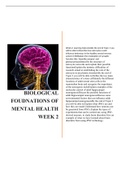Week 2: Learning OutcomesBy the end of Topic 1 you
will be able to:Describe how astrocytes could
influence behaviour in the healthy central nervous
system (CNS)Explain the modulation of synaptic
function (the 'tripartite synapse' and
gliotransmission)Describe the structure of
astrocytic networks and explain their possible
functionsExplain the intrinsic difficulties of
research aimed at establishing the role of the
astrocyte in psychiatric disordersBy the end of
Topic 2 you will be able to:Define the two main
characteristics of a stem cellIdentify the different
locations of adult neural stem cells in the
mammalian brain and recognise the importance
of the neurogenic nicheExplain examples of the
molecular control of adult hippocampal
BIOLOGICAL neurogenesisDiscuss the possible functions of
adult hippocampal neurogenesisDiscuss some
environmental factors that can influence adult
FOUDNATIONS OF hippocampal neurogenesisBy the end of Topic 3
you will be able to:Explain what iPSCs are and
how they are made.Understand how neurons can
MENTAL HEALTH be generated from iPSCs.Explain the types of
experiments that can be carried out, using iPSC-
WEEK 2 derived neurons, to study brain disorders.Give an
example of what we have learned about brain
disorders from using iPSC technology.
,Week 2 – building blocks of the brain
Topic 1: Neuron-glial interactions and mental health Part 1A
Introduction (1)
The primary goal of neuroscience, is to understand the mind. That is, how we perceive, move, think, remember.
Or more generally what are the biological basis of our behaviour and our mental wellbeing. So far, studies in the
neurobiology of psychiatric and neurodevelopmental disorders have focused on the role of neurons, seen as the
only determinant of behaviour, a concept that we called neurocentricism.
Another subtopic is the introduction of a different perspective, which has been developing over the last ten to
fifteen years, which sees glial cells in particular astrocytes as fundamental players in determining brain
functions, behaviour, and as a consequence mental health.
Astrocytes morphology and function were introduced in the previous subtopic. Here we should briefly revise
two aspects of astrocyte function, which are important for the role in influencing behaviour. So initially we are
going to look at astrocyte networks, and then we’re going to move to their role in the modulation
of synaptic function, the so-called ‘tripartite synapse’
In part two, we are going to look at astrocytes in the pathology of the central nervous
system, Studies carried out in the past few years have led to the discovery that
astrocytes can modulate behaviour, and this has led to an increase in the interest in the
potential causative on contributing roll in psychiatric disorder. We shall discuss this
putative role of astrocytes in psychiatric disorder and the difficulties that have been
encountered in demonstrating this role and the cellular and molecular mechanism
involved, using studies on depression as an example.
,Astrocytes in the healthy brain
This is an image of astrocyte visualised originally in the 19th century with techniques, such as the silver
impregnation method, which was invented by Camillo Golgi in 1873.
The rising stars of neuroscience
Astrocytes might have an influence on determining our behaviour, but do we actually have any evidence that
astrocytes may indeed affect behaviour?
This image is a micrograph of human astrocytes from a study that Han and colleagues performed 2013. In an
intriguing set of experiments, they transplanted human glial progenitor cells I immunosuppressed mice. These
progenitors survived they migrated long distances and that gave rise to astrocyte with typical features of human
ones which are the ones that we see in red in this picture.
When Han and his colleagues examined the behaviour of these mice, they found mice with human astrocytes
perform better in learning tasks and displayed and improved long-term potentiation, which is as strengthening of
synaptic connection, which is thought to be the mechanism underlying learning and memory. Four astrocytes
may be responsible for human cognitive abilities.
, How can astrocytes affect behaviour?
Well, astrocytes can affect it indirectly, being for example, involved in neuron and development and
maintenance of a stable environment, which is their homeostatic role. However, two function of astrocytes may
potentially make them more directly responsible for behaviour in health and disease, and these are the ability to
release neurotransmitter, the so-called glial transmission and their ability to form astrocytic networks.
Gliotransmission and the tripartite synapse
There is a schematic representation of the three tripartite synapse, that is a synapse composed of three elements.
Two neuronal, the pre- and postsynaptic terminal belonging to two separate neurons and an astrocytic process.
During synaptic activity neurons release neurotransmitters. An astrocyte responds to these neurotransmitters,
which are represented in blue. We have elevations of calcium, and in turn, they control neuronal excitability in
synoptic transmission through calcium dependent release of glial transmitters, which are represented here in red.
The glial transmitter that astrocytes can release are glutamate, GABA, ATP adenosine, D-serine, etc. Every
single transmitter that neurons can also release, and probably also express receptor transporter for all the major
neurotransmitters.




